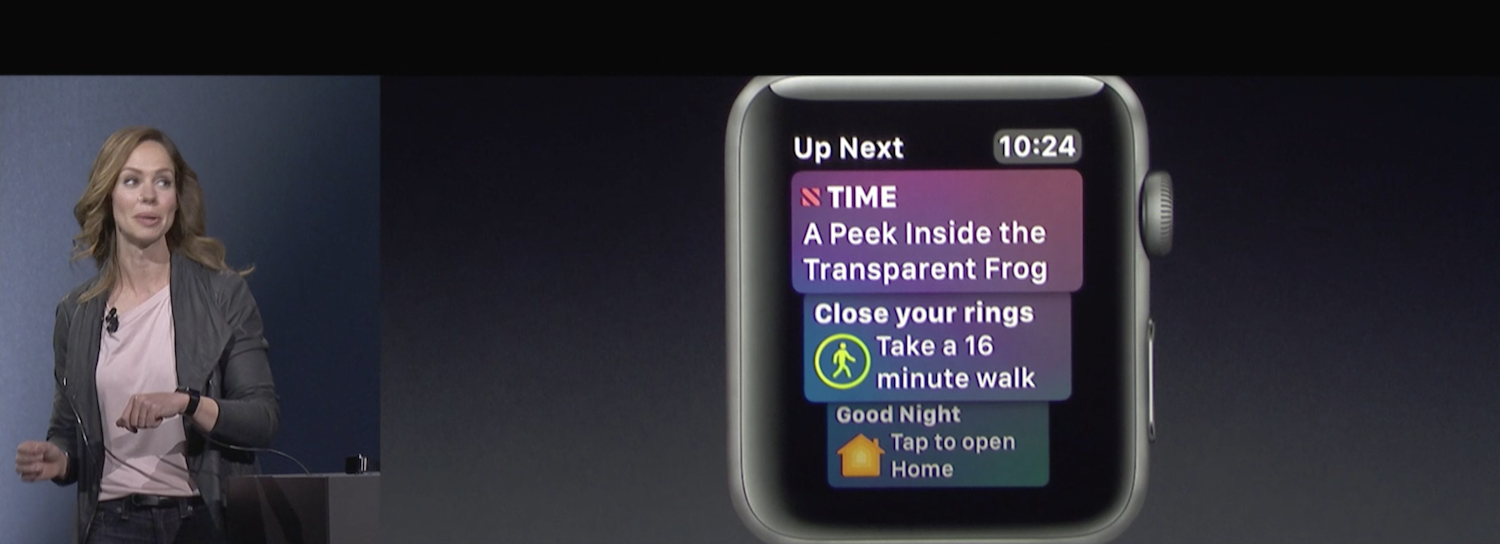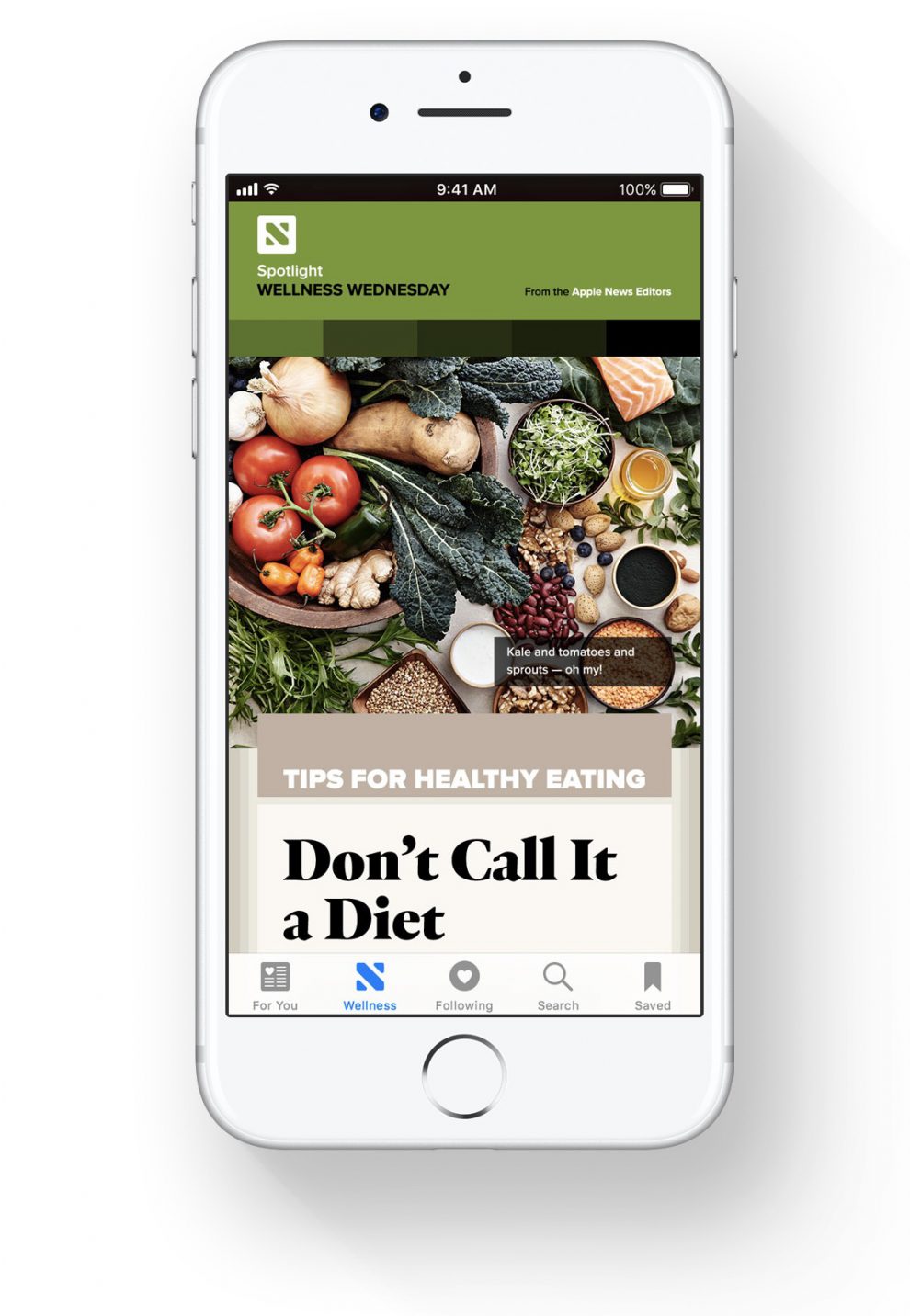
Apple went the first five full months of 2017 without a public event to announce new products, so there was a backup of things to talk about at today’s overstuffed WWDC keynote. As usual, a few of the announcements had impacts on the publishing business; here are the highlights.
HomePod: Apple led its presentation (and picked the name) of the HomePod with music in mind — putting it in a historical line with iTunes and iPods rather than the Amazon Echo. (Its first stated requirement was to “rock the house.”) In the same way the Apple Watch sells fitness as the hook to get a computer strapped on your wrist, HomePod sells music to get a microphone in your home — and for many people, music will be all it gets used for. But it also features the same sort of voice interaction patterns we’ve become familiar with with the Echo and Google Home. That includes some news elements; check out this slide of things you can say to your HomePod — asking for sports results, tuning into NPR, playing podcasts, and “tell me the latest news” are all options:

There was no particular announcement in the keynote about Siri expanding to new classes of apps — though that could easily be something that is announced to developers later in the week or in developer docs just posted. So it’s unclear how open access to these queries will be. (“Hey Siri, ask The New York Times what’s going on in Syria.” “Hey Siri, ask Vox to explain healthcare reform in six minutes.”) But either now or at some point soon, publishers will likely have to decide whether Siri and the HomePod are worth developing for. (Update: The new SiriKit docs say only list-making and note-taking — “Hey Siri, add milk to my shopping list in Things” — are newly supported, so integration with news apps still seems to be theoretical.)
Before investing in building for a platform, publishers like to have an idea how large the addressable market will be. Amazon, the clear leader, doesn’t release sales numbers for its devices (just like the Bezos-owned Washington Post doesn’t tell anyone how many digital subscribers it has, grumble grumble). eMarketer estimates Amazon has 70 percent of the U.S. market, and Morgan Stanley estimated 11 million units sold back in December, pre-holiday rush, the vast majority of them in the United States. Google Home is at a fraction of that.
Amazon has made building Alexa skills quite easy, and its lower price point will likely keep it unthreatened as the market leader (the HomePod will go for $349 when it launches in December). But by putting the HomePod on the Siri platform, developing for it will likely also be able to take advantage of the huge installed base of iPhone and iPad customers. It’s worth watching what sort of access Apple allows developers; if it’s decent, it’s probably worth the time of an engineer or two at most or the largest publishers.
Safari: The new Safari features a couple features of interest to publishers. First, it blocks autoplay videos; Craig Federighi said that Apple will learn over time what sites “shouldn’t” have autoplay — presumably excluding video sites like YouTube. Perhaps more importantly (at least for the adtech world), Safari will do “intelligent tracking prevention,” which seems to be selective blockage of cross-site cookies, the “feature” that lets something you looked at in an online store follow you around the web for days. (Both of these announcements were explicitly made for Macs, but it’s hard to imagine they won’t move to iPhones and iPads at some point.)
Google is heading in a similar direction with Chrome, deciding what ads can and can’t be shown in-browser. Obviously, Google (which makes 90 percent of its revenue from advertising) and Apple (which makes almost none of its) have different incentives influencing their actions — but in both cases, the tech giants who control the leading browsers are using their power to clean up an advertising experience that publishers, adtech, and advertisers haven’t been able to. That raises legitimate antitrust concerns — but it also appears to be a fait accompli at this point. Some news execs are going to see big drops in the monthly play counts, but that’s probably for the best.
iOS 11: In the long run, Apple’s interested in more information workers moving from MacBooks to iPads, but the phone-born iOS hasn’t always worked too well for more significant use. (Try researching a topic across multiple websites and then writing a link-heavy blog post about them on an iPad. Can you do it? Sure. Would you want to? Probably not.)
So iOS 11, announced today and coming out this fall, includes a few updates that’ll be welcomed by, say, reporters in the field. A new multitasking view, based on a rebuilt Dock, looks much more flexible. A better on-screen keyboard should make typing numbers and punctuation easier. A new Files app exposes the file system to users in a way Steve Jobs famously resisted, but which might save you a few hundred “Open In…” dialogues. (This may or may not be linked to Apple’s successful launch of a new file system, which reached macOS today. And the interface can include third-party apps like Dropbox.) Text, images, and other bits of content can now be drag-and-dropped between apps. There’s 3D Touch tab switching in Safari. It’s a package of updates that should make word-based, multi-app work significantly easier.
One other note: Apple is dropping support for 32-bit apps on iOS. It’s unlikely your publisher’s app is 32-bit unless it’s sat ignored for multiple years — actually maybe it’s not that unlikely? you probably have some weird print replica thing from 2012 still in there — but if it is, it’ll stop working this fall.
Apple News: The lil’ distributed-content platform that could, Apple News has been a surprise hit with publishers and audiences alike, with outlets reporting big audiences, especially from push notifications. No big updates made the keynote threshold, but there was an interesting mention in a section about iOS. Siri — which seems to be getting a rebranding from a voice interface to a Google Assistant-style pan-device intelligence system — can now detect what you’re looking at in Safari and suggest news articles about them. The example given was someone searching for travel information about Reykjavík in Safari and then being prompted with Iceland-related news in Apple News.
Some evil genius will figure out the right way to take advantage of this and unleash a new dark science of…Safari-engine optimization?
A couple brief mentions on a slide seem to indicate Apple News videos will now appear in the Today view (which I imagine also means a more prominent treatment for video in the Apple News app) and a new Spotlight tab in the app.
Update: According to promotional materials posted after the keynote ended:
News becomes even more personal, showing top stories that are more relevant to you. Siri learns what’s important to you and suggests stories you might like. And our editors choose a different topic every day for you to explore in a new tab called Spotlight. They also craft a daily selection of the best videos for you to see in Today View.
Plus this image of the Spotlight tab — this is part of what new editor-in-chief Lauren Kern will be working on, presumably:

Note that the current Apple News tab bar goes For You / Favorites / Explore / Search / Saved, so there’s a little bit of swapping going on here.
Miscellaneous: WWDC is about software first and foremost, but there were a few hardware updates. The 9.7″ iPad Pro grew to 10.5″, with smaller bezels; the larger size means keys on the on-screen and Smart Keyboards will be full-sized. MacBooks and iMacs were all updated with faster processors; the iMac also got boosted graphics capacity that should make it more useful for high-end video and VR production, an area where Apple has lagged. The company also announced an upcoming iMac Pro, due in December, which will be even more useful.
Over on the Apple Watch, Apple News is now a native watch app, meaning push notifications can be viewed in a more native and visual environment on the watch. They’ll show up in a new Siri-powered watch face. Still probably only useful to publishers as a prompt to pick up your phone, though.
The iPhone’s camera app now allows a sort of fake long-exposure filter, which at least a few tripod-free photographers will find tempting.
Apple announced new machine learning and augmented reality tools for developers, which sounded impressive and could be of longer-term use to a few publishers.
Finally, despite my hopes, there’s were no desktop Apple News or Podcasts apps announced — a space I’m a little surprised Apple hasn’t moved into yet. (Though the iOS Podcasts app has apparently gotten a redesign — potentially key given that’s by far the most popular places for podcasts to be consumed. And, though we don’t know much about it, a WWDC on Podcasts later this week promises that “iOS 11 upgrades the Apple Podcasts app to support new feed structures for serialized shows” — interesting!)